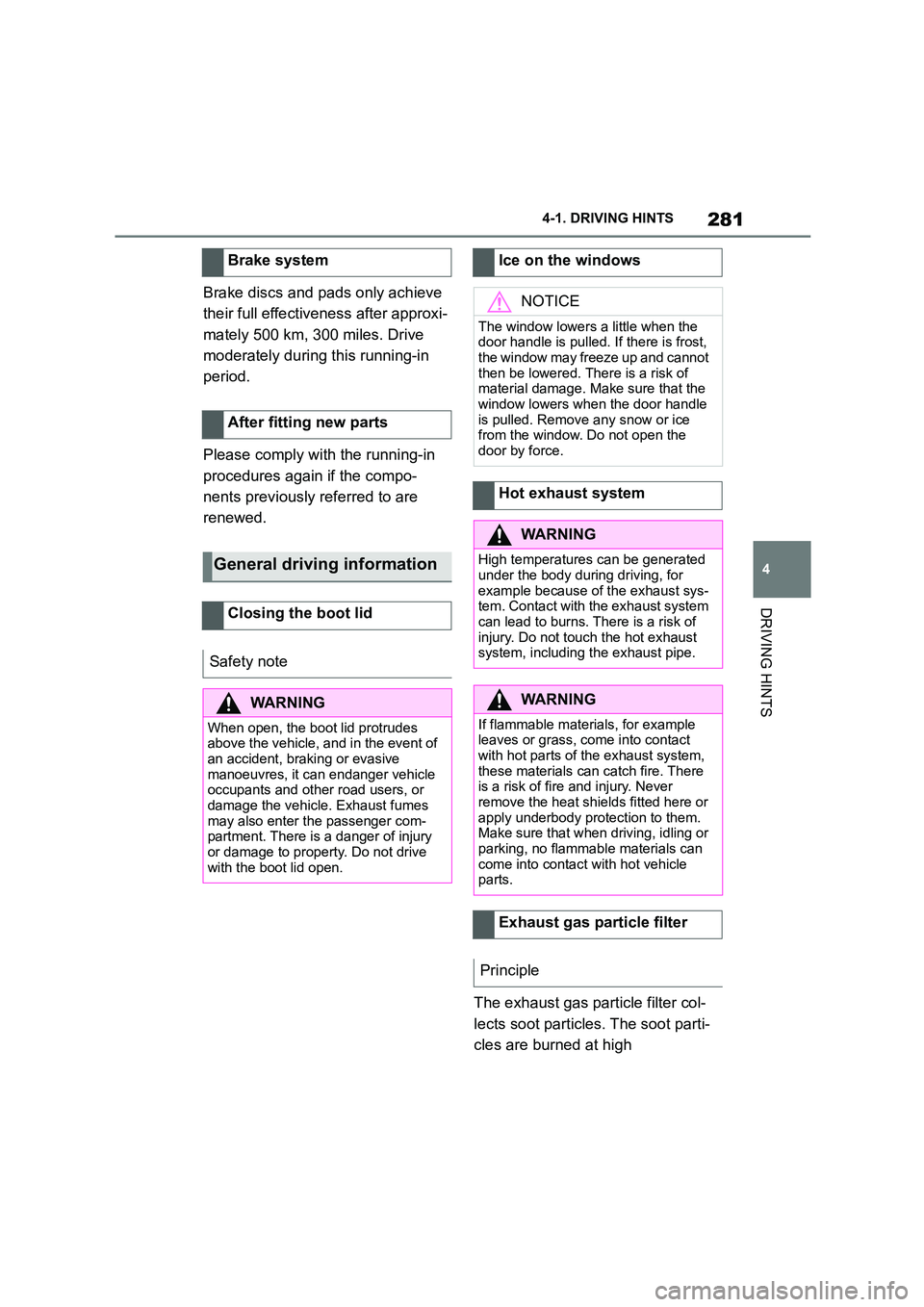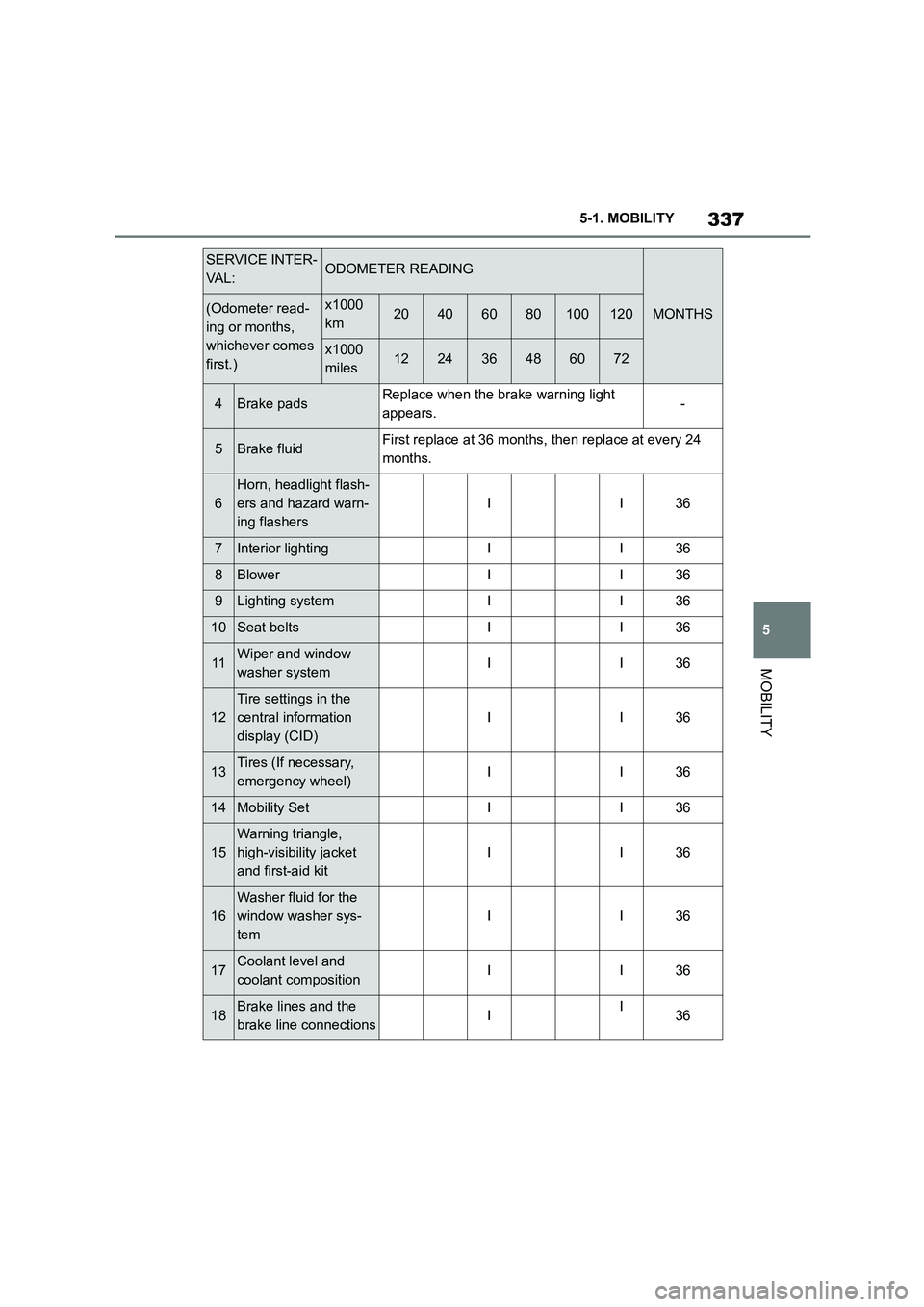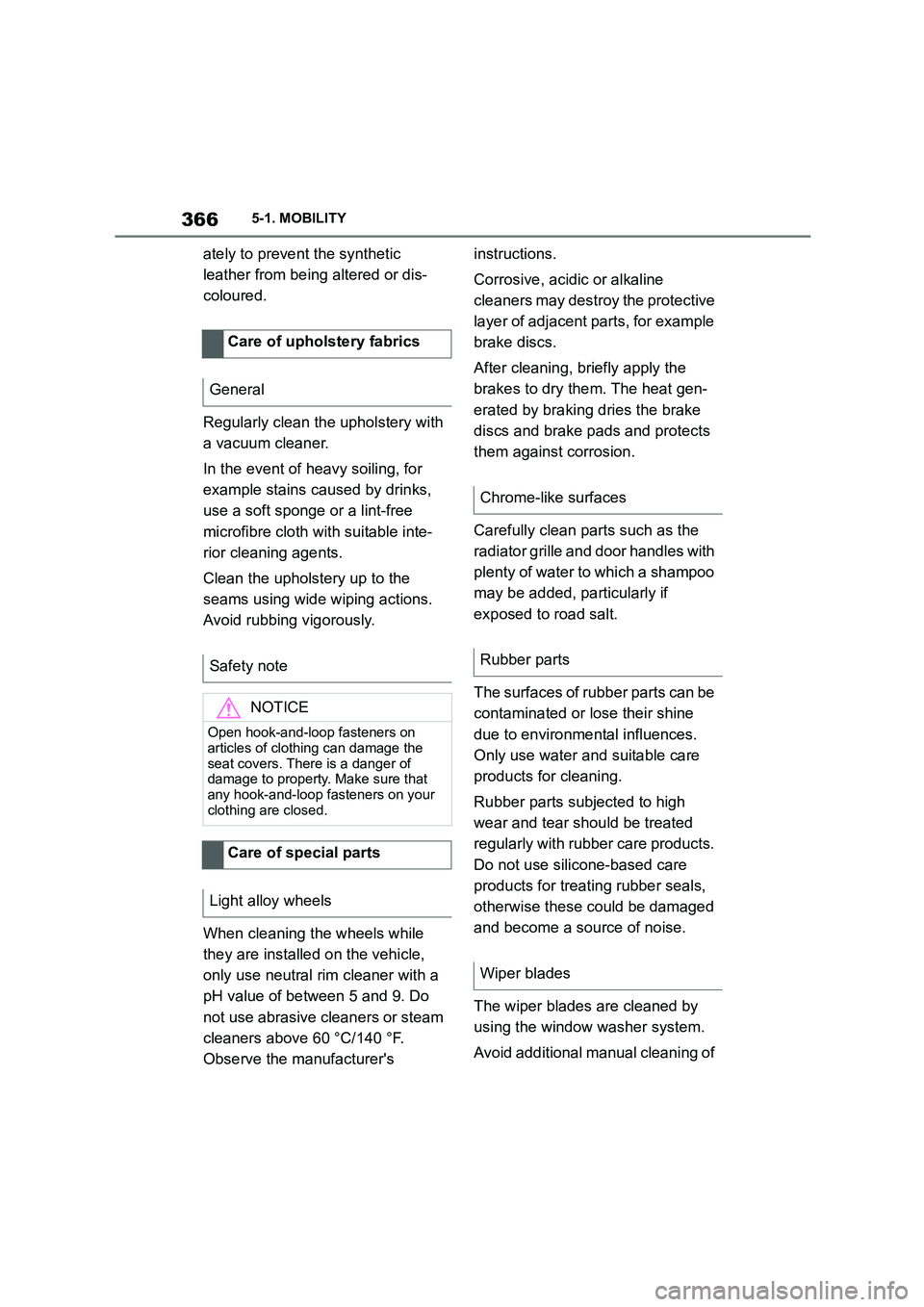2022 TOYOTA SUPRA brake pads
[x] Cancel search: brake padsPage 283 of 498

281
4
4-1. DRIVING HINTS
DRIVING HINTS
Brake discs and pads only achieve
their full effectiveness after approxi-
mately 500 km, 300 miles. Drive
moderately during this running-in
period.
Please comply with the running-in
procedures again if the compo-
nents previously referred to are
renewed.
The exhaust gas particle filter col-
lects soot particles. The soot parti-
cles are burned at high
Brake system
After fitting new parts
General driving information
Closing the boot lid
Safety note
WA R N I N G
When open, the boot lid protrudes above the vehicle, and in the event of
an accident, braking or evasive
manoeuvres, it can endanger vehicle occupants and other road users, or
damage the vehicle. Exhaust fumes
may also enter the passenger com- partment. There is a danger of injury
or damage to property. Do not drive
with the boot lid open.
Ice on the windows
NOTICE
The window lowers a little when the
door handle is pulled. If there is frost, the window may freeze up and cannot
then be lowered. There is a risk of
material damage. Make sure that the window lowers when the door handle
is pulled. Remove any snow or ice
from the window. Do not open the
door by force.
Hot exhaust system
WA R N I N G
High temperatures can be generated
under the body during driving, for example because of the exhaust sys-
tem. Contact with the exhaust system
can lead to burns. There is a risk of injury. Do not touch the hot exhaust
system, including th e exhaust pipe.
WA R N I N G
If flammable materials, for example leaves or grass, come into contact
with hot parts of the exhaust system,
these materials can catch fire. There is a risk of fire and injury. Never
remove the heat shields fitted here or
apply underbody protection to them. Make sure that when driving, idling or
parking, no flammable materials can
come into contact with hot vehicle parts.
Exhaust gas particle filter
Principle
Page 287 of 498

285
4
4-1. DRIVING HINTS
DRIVING HINTS
Ensure that you do not obstruct
other road users when doing so.
The heat generated by braking
dries the brake discs and brake
pads and protects them against
corrosion.
This way, brake power is available
immediately, whenever it is needed.
■General
When driving on long or steep
downhill stretches, use the gear in
which the least braking is required.
Otherwise the brake system can
overheat and the braking effect is
reduced.
Engine braking effect can be addi-
tionally increased by manually shift-
ing down, even into first gear, if
applicable.
■Safety notes
Corrosion of the brake discs and
contamination of the brake pads
increase in the following circum-
stances:
Low mileage.
Extended periods when the vehi-
cle is not used.
Infrequent use of the brakes.
Aggressive, acidic or alkaline
cleaning agents.
During braking, corroded brake
discs may cause brake judder
which usually cannot be eliminated.
When the automatic air condition-
ing is in operation, condensation
develops and exits underneath the
vehicle.
The higher mechanical and thermal
loads involved in driving on racing
tracks lead to increased wear. This
wear is not covered by the war-
ranty. The vehicle is not conceived
for use in motor sports competi-
tions.
Before and after driving on a racing
track, have the vehicle checked at
any authorized Toyota retailer or
Toyota authorized repairer, or any
reliable repairer.
Downhill gradients
WA R N I N G
Even slight continuous pressure on the brake pedal can cause overheat-
ing, brake pad wear or even brake
system failure. There is a danger of accidents. Avoid excessive loads on
the brake.
WA R N I N G
When idling or with the engine switched off, safety-relevant func-
tions, for example engine braking
effect or steering and braking force assistance, are either restricted or not
available at all. There is a risk of acci-
dent. Do not drive at idle speed or with the engine switched off.
Corrosion of the brake discs
Condensation when vehicle
is parked
Driving on a racing track
Page 336 of 498

3345-1. MOBILITY
Your vehicle needs to be serviced according to the normal maintenance
schedule.
Maintenance operations:
I = Inspect, correct or replace as necessary
R = Replace, change or lubricate
Scheduled maintenance (except for Europe and
Australia)
Perform maintenance by the schedule as follows:
Maintenance schedule requirements
Maintenance schedule (except for Korea, Mexico and South
Africa)
SERVICE
INTERVAL:ODOMETER READING
MONTHS(Odometer
reading or
months, which-
ever comes
first.)
x1000
km1224364860728496
x1000
miles7.214.421.628.83643.250.457.6
BASIC ENGINE COMPONENTS
1
Engine oil (Include
engine oil filter)
<
RRRRRRRR12
IGNITION SYSTEM
2Spark plugsRRRR24
FUEL AND EMISSION CONTROL SYSTEMS
3Air filterRRRR24
CHASSIS AND BODY
4Brake padsReplace when the brake warning light
appears.-
5Brake fluidFirst replace at 36 months, then replace at every 24
months.
Page 339 of 498

337
5
5-1. MOBILITY
MOBILITY
4Brake padsReplace when the brake warning light
appears.-
5Brake fluidFirst replace at 36 months, then replace at every 24
months.
6
Horn, headlight flash-
ers and hazard warn-
ing flashers
II36
7Interior lightingII36
8BlowerII36
9Lighting systemII36
10Seat beltsII36
11Wiper and window
washer systemII36
12
Tire settings in the
central information
display (CID)
II36
13Tires (If necessary,
emergency wheel)II36
14Mobility SetII36
15
Warning triangle,
high-visibility jacket
and first-aid kit
II36
16
Washer fluid for the
window washer sys-
tem
II36
17Coolant level and
coolant compositionII36
18Brake lines and the
brake line connectionsII36
SERVICE INTER-
VA L :ODOMETER READING
MONTHS(Odometer read-
ing or months,
whichever comes
first.)
x1000
km20406080100120
x1000
miles122436486072
Page 365 of 498

363
5
5-1. MOBILITY
MOBILITY
■Safety note
■General
In a car wash, the vehicle must be
able to roll freely.
To roll or push the vehicle, see
page 156.
Some car washes require you to
get out of the vehicle. It is not possi-
ble to lock the vehicle from the out-
side in selector lever position N. If
an attempt is made to lock the vehi-
cle, a signal sounds.
Ensure that the remote control is
located in the vehicle.
Switch on drive-ready state, see
page 55.
Do not rub wet headlights dry and
do not use abrasive or corrosive
cleaning agents.
Soak impurities such as insect resi-
dues with shampoo and wash off
with water.
Remove ice with a de-icer spray; do
not use an ice scraper.
After the vehicle has been washed,
briefly apply the brakes to dry them
otherwise braking effectiveness
may be temporarily reduced. The
heat generated by braking dries the
brake discs and br ake pads and
Automatic car washes
Safety notes
NOTICE
If high-pressure washers are used, water may penetrate the area around
the windows. There is a danger of
damage to property. Avoid high pres-
sure washers.
NOTICE
The vehicle can be damaged if auto-
matic washing bays or car washes are used incorrectly. There is a dan-
ger of damage to property. Observe
the following notes:
●Textile car washes or systems
using soft brushes are preferable,
to avoid damage to the paintwork.
●Avoid washing bays or car washes
with guide rails higher than 10 cm,
4 in, to avoid damage to the body.
●Note the maximum tyre width of the
guide rail to avoid damage to tyres and rims.
●Fold in the exterior mirrors to avoid damaging them.
●Deactivate the wipers and the rain sensor (if fitted) to avoid damage to
the wiper system.
Entering a car wash
NOTICE
Selector lever position P is automati-
cally engaged when standby state is
switched off. There is a danger of damage to property. Do not switch off
standby state in car washes.
Exiting from a car wash
Headlights
After washing the vehicle
Page 368 of 498

3665-1. MOBILITY
ately to prevent the synthetic
leather from being altered or dis-
coloured.
Regularly clean the upholstery with
a vacuum cleaner.
In the event of heavy soiling, for
example stains caused by drinks,
use a soft sponge or a lint-free
microfibre cloth with suitable inte-
rior cleaning agents.
Clean the upholstery up to the
seams using wide wiping actions.
Avoid rubbing vigorously.
When cleaning the wheels while
they are installed on the vehicle,
only use neutral rim cleaner with a
pH value of between 5 and 9. Do
not use abrasive cleaners or steam
cleaners above 60 °C/140 °F.
Observe the manufacturer's
instructions.
Corrosive, acidic or alkaline
cleaners may destroy the protective
layer of adjacent parts, for example
brake discs.
After cleaning, briefly apply the
brakes to dry them. The heat gen-
erated by braking dries the brake
discs and brake pads and protects
them against corrosion.
Carefully clean parts such as the
radiator grille and door handles with
plenty of water to which a shampoo
may be added, particularly if
exposed to road salt.
The surfaces of rubber parts can be
contaminated or lose their shine
due to environmental influences.
Only use water and suitable care
products for cleaning.
Rubber parts subjected to high
wear and tear should be treated
regularly with rubber care products.
Do not use silicone-based care
products for treating rubber seals,
otherwise these could be damaged
and become a source of noise.
The wiper blades are cleaned by
using the window washer system.
Avoid additional manual cleaning of
Care of upholstery fabrics
General
Safety note
NOTICE
Open hook-and-loop fasteners on articles of clothing can damage the
seat covers. There is a danger of
damage to property. Make sure that any hook-and-loop fasteners on your
clothing are closed.
Care of special parts
Light alloy wheels
Chrome-like surfaces
Rubber parts
Wiper blades
Page 494 of 498

492Alphabetical Index
RES CNCL button, see Cruise Con-
trol ............................................... 234
RES CNCL button, see Dynamic
radar cruise control ................... 238
Reset, Tyre Pressure Monitor TPM
..................................................... 307
Restraint systems for children, see
Carrying children safely ............ 122
Retreaded tyres ............................ 297
Reuse, recycling ........................... 333
Reversing light, replacing Bulbs, see
Bulbs and lights ......................... 340
Revolution counter....................... 168
Right-hand tra ffic, light setting ... 190
Rim cleaner, light alloy wheels ... 366
RON, petrol grade......................... 323
Roof lining....................................... 49
Roof load ....................................... 371
Rope for tow-starting/towing....... 360
RSC Runflat System Component,
see Run-flat tyres ....................... 298
Rubber parts, care........................ 366
Run Flat tyres, see Run-flat tyres 298
Run-flat tyres ................................ 298
Running in..................................... 280
Running in brake discs, see Brake
system ......................................... 281
Running in brake pads, see Brake
system ......................................... 281
Run-on of fan, see Exhaust gas parti-
cle filter ....................................... 281
S
Safe seating position ................... 107
Safety systems, see Airbags ....... 192
Safety systems, see Toyota Supra
Safety .......................................... 205
Saving energy, see Shift position
indicator ...................................... 171
Saving fuel .................................... 286
Screen Mirroring, connection........ 85
Screen, see Control Display .......... 59
Screwdriver, see On-board tool kit
..................................................... 339
Sealant, see Mobility System.......299
Seat belt reminder for driver and
front passenger seat .................. 116
Seat belts ....................................... 111
Seat belts, care .............................367
Seat heating .................................. 120
Seat, see Memory function .......... 119
Seats, front .................................... 107
Securing a transported load ........ 276
Selection list in the instrument clus-
ter .................................................177
Selector lever, Automatic transmis-
sion ..............................................154
Sensors of the vehicle.................... 50
Sensors, care ................................367
Service requirement, see CBS Con-
dition Based Service ..................330
Service requirements ................... 170
Service, see Breakdown assistance
..................................................... 353
Settings on the Control Display .... 71
Settings, locking/unlocking .........101
Shift Lights, revolu tion counter .. 168
Shift paddles on the steering wheel
..................................................... 154
Shift position indicator................. 171
Side airbag .................................... 193
Side lights......................................186
Side nozzles, see Ventilation .......266
Signal horn, horn ............................ 46
Signals on unlocking, see
Acknowledgement signals ........ 102
Sizes, see Dimensions ................. 370
Smallest turning circle ................. 370
Smart Key System .......................... 96
Snow chains .................................. 304
Socket for on-board diagnosis OBD
..................................................... 332
Sockets, connecting electrical appli-
ances, see Sockets .................... 269
Soot particle filter, see Exhaust gas
particle filter ................................281
SOS button, see Automatic emer-
gency call .................................... 355
Spanner, see On-board tool kit.... 339